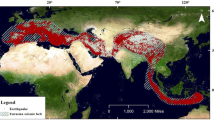Abstract
In this study, we present the fractal characteristics of the spatio-temporal sequence for seismic activity in the circum-Pacific seismic belt and vicinity regions, which is one of the most active seismic zones worldwide. We select the seismic dataset with magnitude \(M\ge 4.4\) in the circum-Pacific seismic belt region and its vicinity from 1900–2015 as the objects. Based on the methods of capacity dimension and information dimension, using \(\hbox {ln}(1/\delta )\)–\(\hbox {ln }N(\delta )\) of the relationship to evaluate and explain, the results show that (1) in the circum-Pacific seismic belt and the surrounding areas, for the seismic activity with magnitude \(M\ge 4.4\), the time series dimension is 0.63, the spatial distribution dimension is 0.52 and they have fractal structure. (2) For the earthquakes with \(M\ge 7.0\), the time series dimension increases greatly, which indicates that the cluster characteristics in time is greatly reduced. And the earthquakes with magnitude \(7.0 \ge M \ge 4.4\) have significant impact on the characterized by clustering in time in the study region. (3) There is significant fractal structure at spatio-temporal distribution of earthquakes in the circum-Pacific seismic belt. It reveals the tectonic movements keep continuous, obvious anisotropism characteristic of geological structure and the distribution of surface stress field is spatio-temporal heterogeneity in the study area.





Similar content being viewed by others
References
Birdi K S 1993 Fractals in chemistry, geochemistry, and biophysics: An introduction, Springer Science & Business Media.
Dimri V P (ed.) 2000 Application of fractals in earth sciences; CRC Press.
Dimri V P 2005 Fractals in geophysics and seismology: An introduction; In: Fractal Behaviour of the Earth System (ed.) Dimri V P, Springer, New York, 207p.
Duda S J 1965 Secular seismic energy release in the circum-Pacific belt; Tectonophys. 2(5) 409–452.
Geilikman M B, Golubeva T V and Pisarenko V F 1990 Multifractal patterns of seismicity; Earth Planet. Sci. Lett. 99(1) 127–132.
Goldberger A L 1996 Non-linear dynamics for clinicians: Chaos theory, fractals, and complexity at the bedside; Lancet 347(9011) 1312–1314.
Higuchi T 1988 Approach to an irregular time series on the basis of the fractal theory; Physica D 31(2) 277–283.
Kagan Y Y and Jackson D D 1991 Long-term earthquake clustering; Geophys. J. Int. 104(1) 117–134.
Li S and Wu G T 2002 Fractal and wavelet; Science Press, Beijing, pp. 208–226.
Ogata Y and Abe K 1991 Some statistical features of the long-term variation of the global and regional seismic activity; Int. Stats. Rev. 59(2) 139–161.
Padhy S, Mishra O P, Subhadra N, Dimri V P, Singh O P and Chakrabortty G K 2015 Effects of errors and biases on the scaling of earthquake spatial pattern: Application to the 2004 Sumatra–Andaman sequence; Nat. Hazards 77(1) 75–96.
Sunmonu L A, Dimri V P, Prakash M R and Bansal A R 2001 Multifractal approach to the time series of M \(>\)7.0 earthquake in Himalayan region and its vicinity during 1985–1995; J. Geol. Soc. India 58(2) 163–169.
Turcotte D L 1997 Fractals and chaos in geology and geophysics; Cambridge university Press.
U.S. Geological Survey, Search Earthquake Catalog, http://earthquake.usgs.gov/earthquakes/search/.
Wang J H and Lee C W 1997 Multifractal measures of time series of earthquakes; J. Phys. Earth 45 331–345.
Zheng W, Li X, Xie J, Yin L and Wang Y 2015 Impact of human activities on haze in Beijing based on grey relational analysis; Rendiconti Lincei 26(2) 187–192.
Zheng W, Li X, Yin L, Yin Z, Yang B, Liu S, Song L, Zhou Y and Li Y 2017 Wavelet analysis of the temporal-spatial distribution in the Eurasia seismic belt; Int. J. Wavelets, Multiresolution and Information Processing 15(3) 1750018.
Zhuang J, Ogata Y and Verejones D 2002 Stochastic declustering of space-time earthquake occurrences; J. Am. Stat. Assoc. 97 369–380.
Acknowledgements
Research supported by Fundamental Research Funds for the Central Universities (Nos. SWU117063, SWU116183 and XDJK2011C086); Funds for International S&T Cooperation and Exchange R&D Project of Sichuan Province (Grant No. 2017HH0054); Opening Fund of State Key Laboratory of Virtual Reality Technology and Systems (Beihang University) (Grant No. BUAA–VR–16KF–11).
Author information
Authors and Affiliations
Corresponding author
Additional information
Corresponding editor: N V Chalapathi Rao
Rights and permissions
About this article
Cite this article
Yin, L., Li, X., Zheng, W. et al. Fractal dimension analysis for seismicity spatial and temporal distribution in the circum-Pacific seismic belt. J Earth Syst Sci 128, 22 (2019). https://doi.org/10.1007/s12040-018-1040-2
Received:
Revised:
Accepted:
Published:
DOI: https://doi.org/10.1007/s12040-018-1040-2




